At Victorian Pest Animal Control we provide services for control of the following pest animals. If there is a pest animal on your property requiring control that is not listed below we please contact us for further information.
Please Contact Us today for an obligation free quote and property assessment
We offer flexible rates and base our quotes on a per job basis using either an hourly rate or a 'per animal' fee. We can discuss this with you and help you to determine the most cost effective rate for achieving you desired goals.
We are also able to offer discounted services and cheaper rates for extended bookings and extenuating circumstances.
Please click the links for more info in animal species and control methods
We are the experts in deer control and have many years experience in controlling problem deer populations on private and goverment land. There are four main deer species found in Victoria. They are all introduced species and as such do not require special permits or permission to control with the exception of Hog Deer.
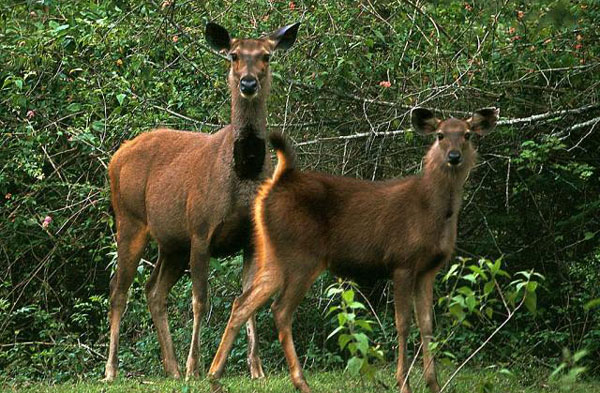
Sambar Deer were first released in Victoria in the early 1860's. They are a highly adaptive, extremely elusive and robust breed of deer that are for the most part solitary, and as such their populations have exploded throughout Victoria since their release. They can now been found in most woodland, bush and farm fringe areas across the entire state. Sambar Deer feed mainly at night and can cause damage to crops, fences and gardens through feeding, as well as competition for grazing with livestock, significant environmental damage to trees and waterways through "rubbing" and "wallowing" and traffic accidents. Sambar deer can be hard to control without experienced and skilled shooters as their feeding and bedding patterns can be difficult to exploit. For a property with a Sambar Deer problem we will typically use trail cameras to record the population density, feeding patterns and regularity, then use the information gathered to put together a viable assessment of the property and a culling plan. This initial assessment is 'no charge and obligation free'.
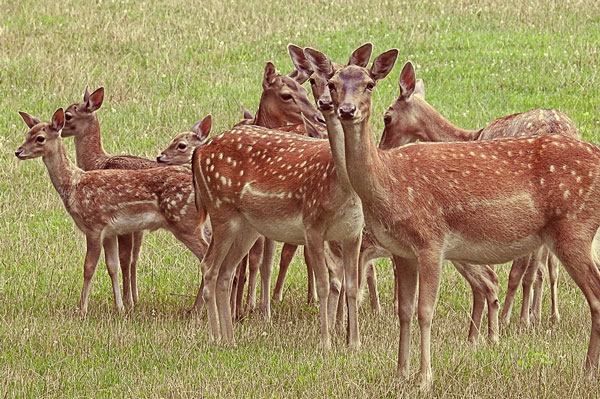
Fallow Deer are a herd animal, meaning the are normally found in small to large population groups. They were first released in Victoria around 1830 and have established solid population bases near farmland in many locations around the state. There are also many domestic populations of Fallow deer that have escaped enclosures or been illegally released that have added to population numbers. Fallow Deer feed mainly at night and can cause damage to crops, fences and gardens through feeding, as well as competition for grazing with livestock, significant environmental damage to trees and waterways through "rubbing" and "wallowing" and traffic accidents. They are normally regular in their movements and as such are easier to control than more solitary deer such as Sambar, however experienced shooters are required to help form solid control plans based on population density and movements. For a property with a Fallow Deer problem we will typically use trail cameras to record the population density, feeding patterns and regularity, then use the information gathered to put together a viable assessment of the property and a culling plan. This initial assessment is 'no charge and obligation free'.
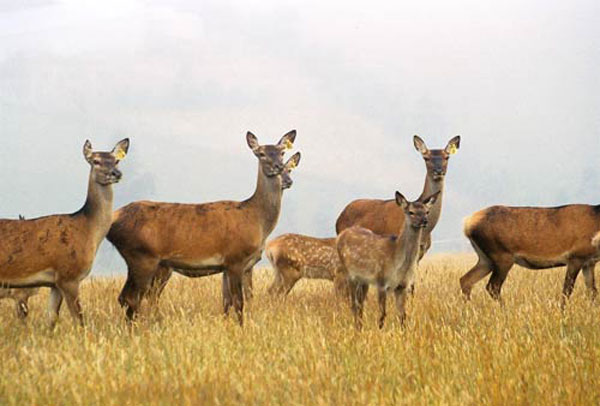
Red Deer are a herd animal with similar patterns to Fallow Deer. They were first released in Australia in 1860 and have developed strong population bases in Queensland, New South Wales and Victoria. There are also many domestic populations of Red Deer that have escaped enclosures or been illegally released that have added to population numbers. Red Deer feed mainly at night and can cause damage to crops, fences and gardens through feeding, as well as competition for grazing with livestock, significant environmental damage to trees and waterways through "rubbing" and "wallowing" and traffic accidents. They are normally regular in their movements and as such are easier to control than more solitary deer such as Sambar, however experienced shooters are required to help form solid control plans based on population density and movements. For a property with a Red Deer problem we will typically use trail cameras to record the population density, feeding patterns and regularity, then use the information gathered to put together a viable assessment of the property and a culling plan. This initial assessment is 'no charge and obligation free'.
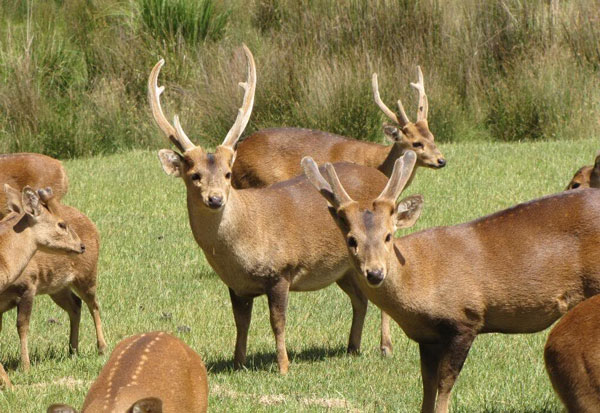
Hog Deer are normally found in Coastal Tea Tree Swamp Areas and are not often a problem for land owners because of the habitat they prefer. Hog Deer are protected under the Wildlife Act and as such an Authority To Control Wildlife permit must be acquired before and control can take place. If you do have a problem with Hog Deer we can apply for an ATCW permit on your behalf and control can place using standard methods when/if the permit is approved.
Other Deer species such as Chital (Axis axis) or Rusa (Rusa timorensis) are not as prevalent but may also be a problem in Victoria. We can asses this on a case by case basis.
Our normal control method for deer is shooting during early evening or morning and/or after dark using highly skilled shooters, high powered rifles with Night Vision and Thermal Imaging Equipment. We find this to be the most effective and ethical method of deer control. Because the use of high powered rifles is required (for legal and ethical reasons) the property size and location will have an impact on our assessment plan. If the property is under 10 acres or in a 'populous area' we may need to arrange for a 'Populous Place Permit' through the local District Firearms Office. If a 'Populous Place Permit' is submitted and rejected and therefore we cannot complete the control project on your property there will be no charge for assessment and administrative work.
Rabbits have been significant pests in Australia since they were released near Geelong, Victoria in 1860. Rabbits are one of Australia's most serious pest animals and typically:
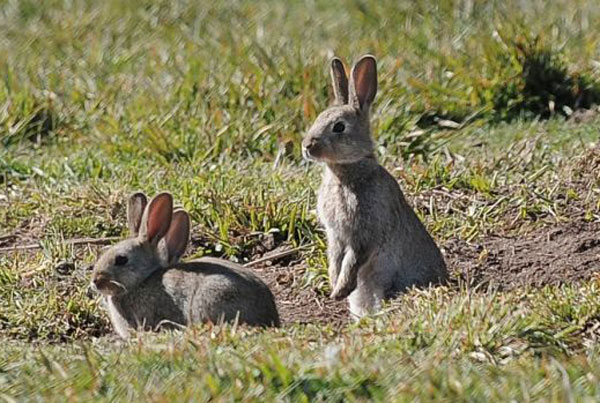
In 2004 rabbits were estimated to have an annual economic impact of over $113 million dollars nationally.
(above information taken from the Agriculture Victoria Website)
While large rabbit populations are best initially controlled with poisoning. Shooting of rabbit populations is a more effective method for control of medium to small populations, especially those populations that have become immune to poisons and viruses such as Myxomatosis and Calicivirus. Some clients may also be reluctant to release poisons due to collateral damage that may be a danger to non target species.
Rabbit control is normally initiated with a visit to the property to determine the population size and locations as well as a realistic assessment of the time required to bring the rabbit population down to acceptable levels. Normal rabbit control involves one or two initial shoots to reduce the bulk of the population, then some regular maintenance shoots to help keep populations at an acceptable level. Regularity of the maintenance visits are normally decided by the client using their own assessment of the current rabbit population. Rabbit control is performed by one or more staff with a .22 rifle using sub sonic (low noise) rounds to reduce disturbance to clients and neighbors. Early evening is the preferred time. We also use thermal monoculars and night vision scopes rather than spotlights as we find this a more effective, ethical and lower impact form of control.
Permits are not required for rabbit control on most private properties over 5 acres. However, if the property is under 5 acres or in a 'populous area' we may need to arrange for a 'populous place permit' through the local District Firearms Office.
Foxes are an introduced species that are very adaptable and extremely destructive to local wildlife and livestock. Unfortunately, foxes have a predisposition towards "thrill killing" where they are inclined to kill not simply for food, but because they are excited by the act itself. This can mean that only one or two problem foxes can cause extensive damage that far exceeds their personal food requirements. We have seen entire chicken populations destroyed in one night by a single animal. Foxes are also opportunistic feeders and are attracted from long distances by the smell of blood, which means new born lambs are particularly vulnerable. These kinds of destructive acts can be devistating to the land owner both financially and emotionally.
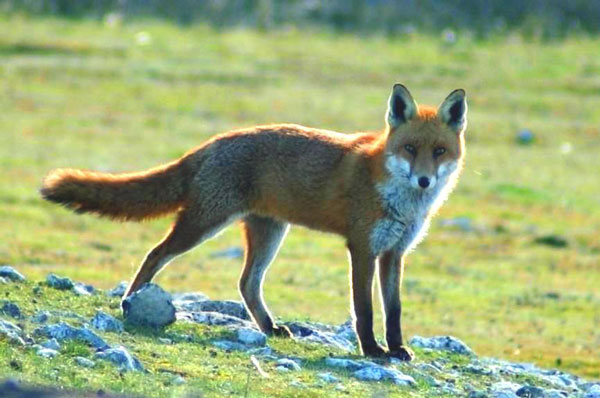
Our fox control methods include shooting over a caller, or using an attractor bait. It's important to understand that skilled shooters are required for this type of fox control because a fox that has been 'called in' or 'baited in' then shot at and missed, will quickly learn to avoid those situations in the future and can become very elusive and hard to control. They can also learn to avoid spotlights as well.
Fox control is normally initiated with a visit to the property to determine the population size and damage being caused, as well as a realistic assessment of the time required to bring the fox population down to acceptable levels. Normal fox control involves one or two initial shoots to reduce the bulk of the population, then some regular maintenance shoots to help keep populations at an acceptable level. Regularity of the maintenance visits are normally decided by the client using their own assessment of the current fox population.
Fox control is performed by one or more staff with a .22 rifle using sub sonic (low noise) rounds to reduce disturbance to clients and neighbors. However, on larger more problematic properties where foxes are difficult to control we can discuss the use of larger centre fire rifles that can assist extended shooting range. Early evening is the preferred time. We also use thermal monoculars and night vision scopes rather than spotlights as we find this a more effective, ethical and lower impact form of control.
Permits are not required for fox control on most private properties over 5 acres. However, if the property is under 5 acres or in a 'populous area' we may need to arrange for a 'populous place permit' through the local District Firearms Office.
Wild dogs in Australia are one of the most problematic introduced predators. Usually much larger than foxes, and often running in packs, wild dogs are capable of high levels of damage to local wildlife and livestock, including attacks on larger cattle such as sheep. Problematic wild dogs populations can cause large financial and emotional hardship to property owners.
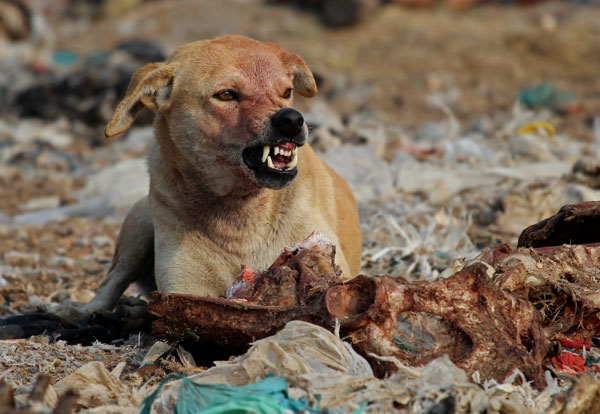
Wild dog control methods are similar to fox control, shooting over callers or using attractor baits. It's important to understand that skilled shooters are required for this type of dog control because a dog that has been 'called in' or 'baited in' then shot at and missed, will quickly learn to avoid the same situations in the future and can become very elusive and hard to call in. They can also learn to avoid spotlights as well which makes night work difficult.
Wild dog control shooting is performed by one or more staff with a medium caliber rifle. Early evening is the preferred time. We also use thermal monoculars and night vision scopes rather than spotlights as we find this a more effective, ethical and lower impact form of control.
Permits are not required for wild dog control on most private properties over 5 acres. However, if the property is under 5 acres or in a 'populous area' we may need to arrange for a 'populous place permit' through the local District Firearms Office.
Feral Cats can usually be found in larger populations (depending on food supply) closer to semi rural and urban areas. They look similar to domestic cats and can grow to larger sizes. They are opportunistic predators, feeding on a wide range of live prey including many native species of small mammals and birds and even scavenging scraps. Feral Cats are extremely adept hunters and as such can cause significant damage to local wildlife. They are also very elusive, preferring early evening and early morning to hunt for food.

Our Feral Cat control methods include shooting over a caller, or using an attractor bait. It's important to understand that skilled shooters are required for this type of Cat control because a Cat that has been 'called in' or 'baited in' then shot at and missed, will quickly learn to avoid similar situations in the future and can become very elusive and hard to control. They will also learn to avoid spotlights as well. Often a single Feral Cat can be the cause of many unwanted deaths to local wildlife believed to be the work of a larger population, and as such it's not really a numbers game like it is with fox control, more likely a matter of finding and removing one or two problem Cats.
Feral Cat control is normally initiated with a visit to the property to determine if it is one or more animals and the damage being caused. We can then build a realistic assessment of the time required to find and remove the problem Feral Cat/s. It is also important to mention that because Feral Cats are often indistinguishable from pets, we will need to investigate the possibility that the offending Cat is not simply a stray pet. Feral Cat control is performed by one or more staff with a .22 rifle using sub sonic (low noise) rounds to reduce disturbance to clients and neighbors. Early evening is the preferred time. We also use thermal monoculars and night vision scopes rather than spotlights as we find this a more effective, ethical and lower impact form of control.
Permits are not required for Feral Cat control on most private properties over 5 acres. However, if the property is under 5 acres or in a 'populous area' we may need to arrange for a 'populous place permit' through the local District Firearms Office.
Pest birds can cause major damage to crops and property through feeding and nesting. Bird droppings can quickly lead to unsightly and unsanitary conditions causing unhealthy and unsafe conditions in your business or private residence. Bird droppings can also attract other unwanted parasites and insects such as mice, fleas, ticks and other bugs.
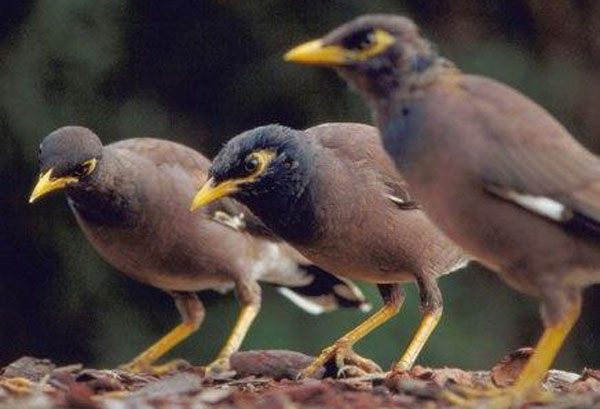
Pest birds can be broken down into 2 categories:
1. Introduced - Introduced birds such as the Domestic Pigeon, Common Starling, Indian Myna and the European BlackBird not protected species and generally do not require a special permit to control.
2. Native - Native birds such as the Galah, Zebra Finch, Red Wattle bird, Silver Gull and Raven (Crow) are often (but not always) protected species. However, special permits can be acquired by us to allow limited control over problem birds.
We control bird populations through shooting only. It's important to understand that we should only be contacted as a last resort. Bird populations can often be deterred using bird spikes, netting, electric shock tracking. If you have tried any or all of the previously mentioned methods, or your property is not conducive to using those methods, we can help you significantly reduce problem bird populations through controlled shooting.
Our bird control methods vary depending on the property size, layout, bird species and population size.
In large open rural areas, where pest birds are flocking and feeding on crops, we will normally use skilled shooters with light shotgun loads to control problem birds. A planned visit to the property on a regular basis during feeding times can not only help reduce bird numbers, but the noise will often deter other flocks from landing in the area. This is a fairly aggressive form of pest bird control, but can be more cost effective than other methods such as netting.
In smaller / indoor / populous areas, such as factories and warehouses, nesting birds can be a real problem, causing damage to stock and unsanitary conditions. For this type of situation we recommend a skilled shooter for a few hours once a month with an air rifle. This is normally enough to clear any problem birds. The air rifles we use are quiet, low muzzle velocity, and do not cause damage to roofs or other structure. We can work in with you to develop a plan to control pest birds in your factory or warehouse after hours.
Kangaroos are probably the most iconic species in Australia and like all native wildlife they are protected in Victoria under the Wildlife Act 1975. They are a highly adaptive animal and are uniquely suited to Australian conditions, leading to extensive over population in some areas. Large populations of Kangaroos in Victoria, most notably the Eastern Grey and Western Grey, can lead to significant damage to crops, fences and gardens, as well as competition for grazing with livestock, traffic accidents and even aggressive behavior towards humans in some cases. While Kangaroos are a protected species in Australia, problem animals may need to be controlled, this can be achieved with an approved Authority To Control Wildlife permit which we can apply for on your behalf.
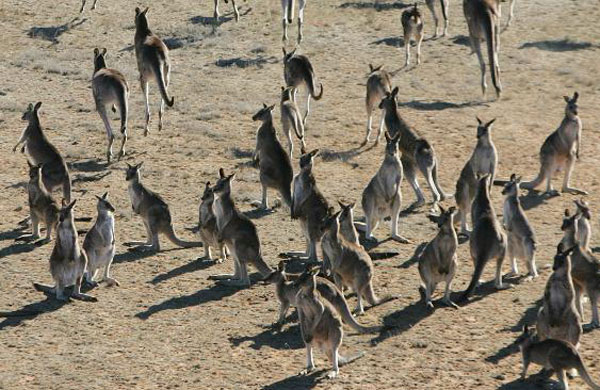
Our normal control method for Kangaroos is shooting during early evening or morning and/or after dark using highly skilled shooters, medium powered centre fire rifles with Night Vision and Thermal Imaging Equipment. Because Kangaroos live in large family groups (mobs) we will typically use a drone to perform an ariel survey of the property prior to commencing control, which allows us to find the mob and develop the best plan for approach. This saves us time and our client money. We find this to be the most effective and ethical method of Kangaroo control. Because the use of medium powered rifles is required (for legal and ethical reasons) the property size and location will have an impact on our assessment plan. If the property is under 10 acres or in a 'populous area' we may need to arrange for a 'Populous Place Permit' through the local District Firearms Office. If a 'Populous Place' permit or an 'Authority To Control Wildlife' permit is submitted and rejected and therefore we cannot complete the control project on your property there will be no charge for assessment and administrative work.
It is worth mentioning that the Kangaroo is an iconic symbol for all Australians and while there may problems caused by overpopulation, many people including neighbors, friends and even us at VPAC hold this animal in a very high regard. We employ the utmost respect and discretion when handling Kangaroo control jobs and we ask the our clients maintain these standards with us throughout the job.
Feral Goats cause significant damage to land and crops through grazing and strip browsing. Trampling hooves also damages vegetation and the soils crust, leading to death of cover vegetation and erosion. Goats will eat almost anything but they are selective browsers, meaning they will selectively eat one species of plant, not allowing that plant time to regenerate. Goats are also capable of climbing trees if the conditions are right, allowing them to graze at higher levels than other animals such as Kangaroos or Deer.
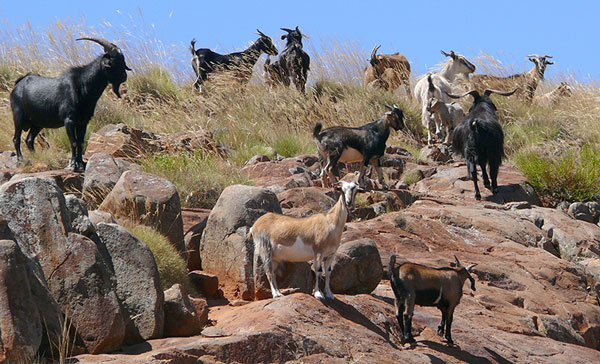
Our normal control method for Feral Goats is shooting during early evening or morning and/or after dark using highly skilled shooters, medium powered centre fire rifles with Night Vision and Thermal Imaging Equipment. Because Feral Goats live in large family groups (mobs) we will typically use a drone to perform an ariel survey of the property prior to commencing control, which allows us to find the mob and develop the best plan for approach. This saves us time and our client money. We find this to be the most effective and ethical method of Feral Goat control.
Because the use of medium powered rifles is required (for legal and ethical reasons) the property size and location will have an impact on our assessment plan. If the property is under 10 acres or in a 'populous area' we may need to arrange for a 'Populous Place Permit' through the local District Firearms Office. If a 'Populous Place' permit is submitted and rejected and therefore we cannot complete the control project on your property there will be no charge for assessment and administrative work.
Feral Pigs are not normally a major concern in Victoria with most populations found in the north of the state. They can, however, cause significant damage in bushland and agricultural areas when populations are high. Damage is caused by trampling and rooting through undergrowth as well as feeding on everything from earth worms and frogs to small birds and even newborn lambs. Feral Pig populations have also been known to spread disease that can be devastating to commercial pig populations and even humans.
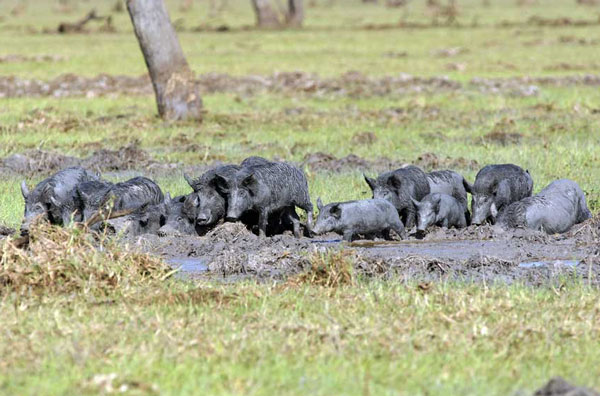
Our normal control method for Feral Pigs is shooting during early evening or morning and/or after dark using highly skilled shooters, medium powered centre fire rifles with Night Vision and Thermal Imaging Equipment. Because Feral Pigs live in large family groups we will typically use a drone to perform an ariel survey of the property prior to commencing control, which allows us to find the mob and/or likely areas usually close to water and develop the best plan for approach. This saves us time and our client money. We find this to be the most effective and ethical method of Feral Pig control.
The use of medium powered rifles is required Feral Pig control (for legal and ethical reasons) and as such the property size and location will have an impact on our assessment plan. If the property is under 10 acres or in a 'populous area' we may need to arrange for a 'Populous Place Permit' through the local District Firearms Office. If a 'Populous Place' permit is submitted and rejected and therefore we cannot complete the control project on your property there will be no charge for assessment and administrative work.
Unit 14 / 18 Prospect Place, Boronia,
VIC, Aust 3155
Ph: 03 9720 4480
Email: info@vicpestanimalcontrol.com.au
